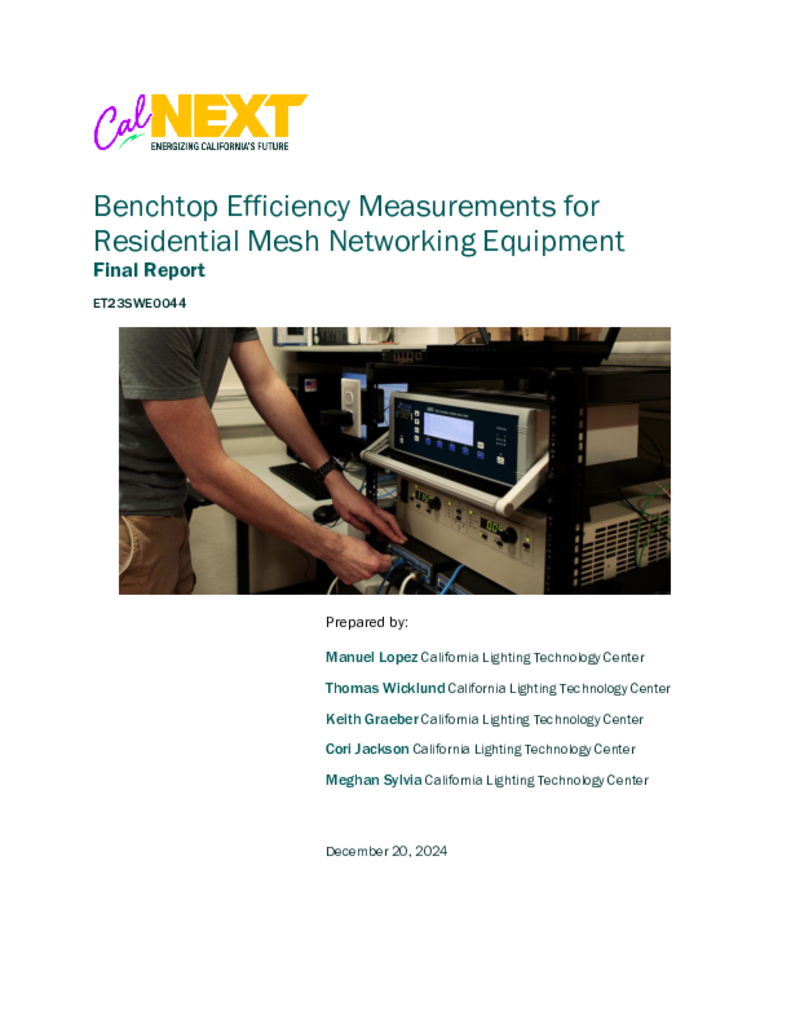ET23SWE0044 - Benchtop Efficiency Measurements for Residential mesh Networking Equipment
In recent years networking equipment manufacturers have expanded from their core product lines and have developed and promoted mesh networking systems (MNS) for residential consumers. Currently, 40% of manufacturers’ advertised Integrated access device (IAD) products are MNS. Unlike the previous generation of IADs, MNS are a group of devices from a single manufacturer and are typically purchased as a package that establishes a single integrated Wi-Fi network that can be accessed at multiple points. By having multiple points at which a device can connect, it is easier for consumers to place devices in key locations within the home to ensure proper signal connectivity and reliability, this greatly increases the adaptability of a system over traditional approaches with a single access point. With recommended IAD lifespans being 3-5 years and based on previous product generational adoptions it is estimated that within 5 years MNS would account for 80% of the IAD installed base. Due to this impending turnover it is critical to note that MNS devices’ electrical characteristics are not well defined by manufacturers nor well understood by researchers and may significantly increase IAD energy consumption which was estimated to be 1.5 TWh in 2020 within California alone.
IADs within the U.S. are mainly regulated by the Voluntary Agreement for Ongoing Improvement to the Energy Efficiency of Small Network Equipment. Providing energy targets and constraints for residential networking equipment. However, this agreement focuses on individual devices and does not have a method of assessing the performance of a group of devices which is a core component of MNS.
The proposed project aims first to conduct a market assessment of today’s commercially available mesh networking systems. In which the project will identify available options within the U.S., with a particular interest in MNS offered by internet service providers, and identify the system’s advertised functions and capabilities. Additionally, the project will query manufacturers on upcoming MNS products and their overall expected presence in future product offerings.
Secondly, the project will conduct laboratory evaluations to characterize and compare overall performance in multiple operational states and conditions experienced within residential environments. Since these systems are modular, systems will be evaluated with varying access points to assess flexibility and overall system response based on the reduction or addition of additional mesh devices. Researchers will compare MNS performance to business as usual IADs to identify any additional energy use or savings along with the associated performance benefits.
Lastly, the project aims to identify the areas where available MNS can improve such as low power mode features or manufacturer recommended node topologies. The project team also anticipates recommending overall approaches to assessing MNS devices and giving input on available opportunities for new regulation or integration into existing standards or voluntary agreements.
The California Lighting Technology Center is uniquely qualified to assess mesh networking systems due to ongoing efforts assessing traditional small networking equipment including routers, modems, extenders, and optical network terminals within CEC’s ongoing Plug Load Energy Testing to Inform Codes and Standards (PLETICS) project. And have a vast amount of experience assessing networked lighting controls, many of which have utilized mesh network architectures for the last decade.
Mesh Networking Systems (MNS) are advanced residential networking solutions that utilize interconnected nodes to deliver seamless, reliable wireless coverage throughout a home. Unlike traditional single-router setups, MNS promise broader and more consistent connectivity, eliminating dead zones by using multiple access points to extend coverage. This project aimed to evaluate the overall performance, energy efficiency, cost-effectiveness, and user-friendliness of MNS. It sought to provide consumers with data-driven insights into whether MNS products offer a viable alternative to traditional solutions and to assess their performance under non-idle conditions. The team conducted a market assessment reviewing 60 MNS products from eight manufacturers. After this a subset of devices across multiple wireless protocols underwent comprehensive testing, including energy consumption measurements under different traffic conditions, as well as attenuation tests to simulate signal obstructions. Data indicates that energy consumption of an MNS increases significantly when additional nodes are energized. On average, the total system power consumption nearly tripled when the MNS configuration was expanded from one to three nodes. Additionally, active data transmission significantly impacts MNS energy use, with power consumption increasing by an average of 44.3 percent during traffic testing and 23.2 percent during attenuation testing. In some cases, overall power consumption more than doubled compared to idle conditions, depending on operating conditions and traffic throughput. When calculating the unit energy consumption (UEC) for the entire system, results showed an average energy increase of 188 percent, nearly three times higher than a single node's idle performance. Additionally, traffic conditions led to a 2.49 percent increase in UEC, and attenuation conditions resulted in an average increase of 18.25 percent.

